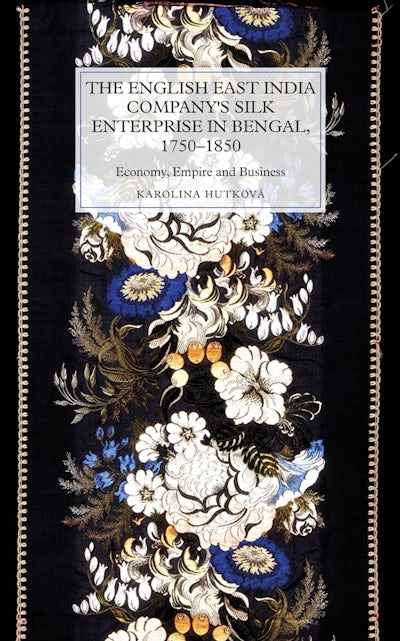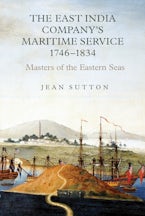
Title Details
275 Pages
23.4 x 15.6 cm
5 b/w, 18 line illus.
Series: Worlds of the East India Company
Series Vol. Number:
16
Imprint: Boydell Press
The English East India Company's Silk Enterprise in Bengal, 1750-1850
Economy, Empire and Business
- Description
- Contents
- Reviews
This book examines the silk-processing activities of the English East India Company in Bengal.
This book examines the silk-processing activities of the English East India Company in Bengal and presents the Company as a manufacturer rather than a trading body or political agent. Silk was one of the first globally traded commodities; its luxury status and potential to create tax revenues and employ the poor gave it a strategic importance in many economies in Eurasia. The silk industry was also an important sector in Britain; yet, as raw silk could notbe produced domestically, the British government encouraged companies to source supplies from its colonies and the territories under its influence. Such projects proved to be challenging; the most successful was the English EastIndia Company's venture in Bengal, where the Company invested over 1 million into developing raw silk production to meet the demands of British weavers. A key component was the transfer of silk technologies from the West to the East - one of the first in this direction rather than vice versa. The outcome of this enterprise was influenced by the business and management capacities of the Company and by British and, eventually, imperial policies, with serious consequences for the Indian economy. The book ultimately presents a case of manufacturing failure, but one resulting from British imperial policies rather than colonial economies.
KAROLINA HUTKOVÁ is an LSE Fellow in Economic History at the London School of Economics and Political Science.
This book examines the silk-processing activities of the English East India Company in Bengal and presents the Company as a manufacturer rather than a trading body or political agent. Silk was one of the first globally traded commodities; its luxury status and potential to create tax revenues and employ the poor gave it a strategic importance in many economies in Eurasia. The silk industry was also an important sector in Britain; yet, as raw silk could notbe produced domestically, the British government encouraged companies to source supplies from its colonies and the territories under its influence. Such projects proved to be challenging; the most successful was the English EastIndia Company's venture in Bengal, where the Company invested over 1 million into developing raw silk production to meet the demands of British weavers. A key component was the transfer of silk technologies from the West to the East - one of the first in this direction rather than vice versa. The outcome of this enterprise was influenced by the business and management capacities of the Company and by British and, eventually, imperial policies, with serious consequences for the Indian economy. The book ultimately presents a case of manufacturing failure, but one resulting from British imperial policies rather than colonial economies.
KAROLINA HUTKOVÁ is an LSE Fellow in Economic History at the London School of Economics and Political Science.
Introduction: Companies, Political Economy and the Great Divergence
Early Modern Silk Industry, Trade and Mercantilism
Empire, the English East India Company and Bengal Raw Silk
Bengal, Piedmont and the English East India Company
The Bengal Silk Industry and the English East India Company
Filatures and Performance in the Bengal Silk Industry
The Bengal Silk Industry and British Laissez-faire Policies
Bengal Raw Silk and British Demand in the Nineteenth Century
Conclusion
Appendix A: Description of the Piedmontese Reeling Machine by Dionysius Lardner
Appendix B: Average Prices of Bengal Raw Silk on the British Market according to the Type of the Silk, 1796-1856
Appendix C: Components of the EEIC's Business Model
Appendix D: Returns to Investment Analysis
Appendix E: Comparison of Manufacturing Costs at the EEIC's Experimental Filature and Common Filature in its Vicinity, 1832
Appendix F: Mechanisation of Silk Throwing in England, 1856
Appendix G: Types of Silkworks Reared in Bengal Silk Districts, 1818
Bibliography
Index
Early Modern Silk Industry, Trade and Mercantilism
Empire, the English East India Company and Bengal Raw Silk
Bengal, Piedmont and the English East India Company
The Bengal Silk Industry and the English East India Company
Filatures and Performance in the Bengal Silk Industry
The Bengal Silk Industry and British Laissez-faire Policies
Bengal Raw Silk and British Demand in the Nineteenth Century
Conclusion
Appendix A: Description of the Piedmontese Reeling Machine by Dionysius Lardner
Appendix B: Average Prices of Bengal Raw Silk on the British Market according to the Type of the Silk, 1796-1856
Appendix C: Components of the EEIC's Business Model
Appendix D: Returns to Investment Analysis
Appendix E: Comparison of Manufacturing Costs at the EEIC's Experimental Filature and Common Filature in its Vicinity, 1832
Appendix F: Mechanisation of Silk Throwing in England, 1856
Appendix G: Types of Silkworks Reared in Bengal Silk Districts, 1818
Bibliography
Index
"[A] welcome addition to our understanding of technology transfer in colonial context and its wider consequences on the colony and the metropole." TECHNOLOGY & CULTURE
"[T]he present book is a welcome addition to the literature. Although the title highlights a narrow segment of the industry, it provides an overall impression of the contemporary global industry." EH.NET
Hardcover
9781783273942
June 2019
$115.00 / £80.00
Ebook (EPDF)
9781787444928
June 2019
$29.95 / £24.99
Title Details
275 Pages
2.34 x 1.56 cm
5 b/w, 18 line illus.
Series: Worlds of the East India Company
Series Vol. Number:
16
Imprint: Boydell Press




















